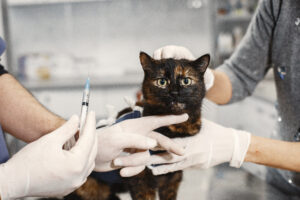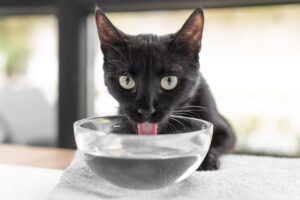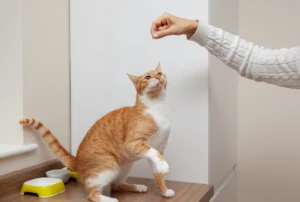Have you ever wondered why do cats groom each other? That sweet moment when one feline friend starts licking another might seem like simple affection, but the truth behind this behavior goes much deeper—and some reasons might actually surprise you.
As cat parents, we’ve all witnessed those tender moments when our feline friends engage in mutual grooming sessions, a behavior scientifically known as allogrooming. While it certainly looks adorable when cats clean each other, this natural behavior serves multiple complex purposes in feline society that date back to their wild ancestors.
In this comprehensive guide, we’ll explore the fascinating reasons why do cats groom each other, the intricate social dynamics behind cat grooming behavior, and some surprising facts about this ritual that might actually concern attentive pet owners.

Understanding Cat Grooming Basics
Before diving into why do cats groom each other, it’s important to understand the significance of grooming in a cat’s life. Cats are famously fastidious creatures, spending up to 50% of their waking hours engaged in some form of grooming activity.
Cats are naturally equipped with special tools for the job:
- Barbed tongues that act like built-in combs
- Moistened paws used like washcloths
- Teeth for removing stubborn debris and parasites
When cats groom each other, they’re engaging in a behavior that serves both practical and social functions. This allogrooming in cats represents one of the most important social bonding mechanisms in feline society.
The 6 Surprising Reasons Why Do Cats Groom Each Other
1. Establishing and Maintaining Social Bonds
One of the primary reasons why do cats groom each other is to strengthen their social connections. Unlike the solitary creatures many believe them to be, domestic cats often form complex social structures, particularly those living in multi-cat households.
When cats engage in mutual grooming, they’re essentially saying, “You’re part of my colony.” This cat social grooming reinforces their group identity and strengthens relationships between cats who consider themselves family.
Dr. Sharon Crowell-Davis, a veterinary behaviorist at the University of Georgia, explains: “When cats groom each other, they’re depositing scent from glands around their mouths onto each other, essentially creating a ‘colony scent’ that identifies them as members of the same social group.”
Research published in the Journal of Veterinary Behavior indicates that cats who regularly engage in allogrooming cats behaviors often show reduced stress levels and fewer behavioral problems. This suggests that when cats clean each other, they’re not just maintaining hygiene—they’re actively cultivating their emotional well-being.

2. Reaching Difficult Areas (And It’s Not Just About Cleanliness)
While it might seem obvious, one practical reason why do cats groom each other is simply to help clean hard-to-reach places. The head, neck, and face areas are particularly difficult for cats to clean themselves, which is why you might often observe cats grooming each other’s faces.
But here’s where things get interesting: when examining why cats lick each other’s ears and faces, researchers have discovered that these areas aren’t chosen randomly. These regions contain scent glands that play crucial roles in feline communication.
When cats groom these areas on another cat, they’re not just cleaning—they’re engaging in a complex exchange of biochemical information. This explains why do cats lick each other in these specific spots more frequently than other areas.
According to a study in the journal Applied Animal Behaviour Science, over 65% of allogrooming in cats focuses on the head and neck region, supporting the theory that this behavior serves purposes beyond mere hygiene.
3. Dominance and Hierarchy Establishment (This Might Concern You)
Here’s where cat grooming behavior explained takes a more surprising turn. While it appears affectionate, when cats groom each other, they might actually be establishing or reinforcing social hierarchies.
Is cat grooming a sign of dominance? Research suggests it often is. Studies of feral cat colonies have revealed that higher-ranking cats frequently initiate grooming sessions with lower-ranking members. This cat grooming hierarchy serves as a non-violent way to maintain social order.
Dr. John Bradshaw, author of “Cat Sense,” notes: “What looks like altruism may actually be an assertion of dominance. The cat doing the grooming is usually the more dominant one in the relationship, and the grooming reinforces this status.”
This explains why do cats groom each other and then fight—the social dynamics at play can shift quickly when a subordinate cat misreads signals or challenges the hierarchy, leading to what appears to be a sudden mood change.
For pet owners, understanding this aspect of why do cats groom each other can help decode seemingly contradictory behaviors in your multi-cat household.

4. Maternal Instinct and Family Bonding
Another significant reason why do cats groom each other relates to maternal behavior. When adult cats groom other adult cats, they’re often exhibiting behaviors learned during kittenhood.
Mother cats meticulously groom their kittens for several important reasons:
- To stimulate breathing and digestion
- To teach kittens proper grooming techniques
- To strengthen mother-kitten bonds
This explains why do kittens groom each other as they grow—they’re mimicking behaviors learned from their mother. This early learning shapes lifelong grooming patterns and explains much about cats grooming bonding behaviors throughout their lives.
When adult cats who aren’t related engage in mutual grooming, they’re essentially treating each other as family. This demonstrates the powerful connection between grooming and trust in feline relationships.
5. Stress Relief and Emotional Regulation
One of the most fascinating reasons why do cats groom each other involves emotional regulation. Research has shown that grooming behaviors release endorphins in a cat’s brain, creating feelings of pleasure and reducing anxiety.
When cats are stressed, they often increase self-grooming behaviors—sometimes to excessive levels. When they extend this behavior to trusted companions, they’re essentially sharing a coping mechanism.
A study published in the Journal of Feline Medicine and Surgery found that cats living in enriched, stress-free environments engaged in 25% more mutual grooming than cats in high-stress situations. This suggests that cat grooming behavior meaning extends beyond physical care into the realm of emotional support.
For cat owners, observing patterns in how cats show affection by grooming can provide valuable insights into the emotional well-being of your pets. Sudden changes in grooming habits might indicate stress or illness that requires attention.
6. Health Monitoring and Disease Prevention (The Scary Part)
Perhaps the most concerning reason why do cats groom each other relates to health monitoring. Cats have incredibly sensitive sensory abilities that allow them to detect changes in another cat’s condition.
When a cat grooms another cat intensively in a specific area, it might be detecting:
- Skin irregularities
- Parasitic infestations
- Wounds or infections
- Early signs of disease
Dr. Gary Landsberg, a veterinary behaviorist, explains: “Cats can detect subtle biochemical changes through taste and smell that might indicate illness. When cats groom each other with unusual focus on one area, it could signal a health issue requiring veterinary attention.”
This aspect of why cats lick and bite each other—sometimes the biting or focused attention indicates they’ve detected something concerning—should prompt pet owners to pay closer attention when grooming patterns change dramatically.
Decoding Different Types of Cat Grooming Behaviors
Now that we understand why do cats groom each other, let’s explore the various forms this behavior can take:
Mutual Grooming in Cats
The most harmonious form of social grooming occurs when two cats take turns grooming each other. This balanced exchange represents the strongest bond between felines and indicates a relationship of mutual trust and respect.
Studies on cat social grooming have found that cats who engage in reciprocal grooming typically spend more time together in other activities as well, suggesting deeply formed social bonds.

One-Sided Grooming
More common than mutual grooming is one-sided grooming, where one cat consistently grooms another without reciprocation. This often reflects the cat grooming hierarchy within your household.
If you’re wondering what does it mean when cats groom each other in this unbalanced way, it typically indicates a clear dominance relationship. The cat doing the grooming is usually the more confident, dominant individual.
Interspecies Grooming
Some cats even extend grooming behaviors to other species—including humans! When your cat licks your hand or hair, they’re treating you as part of their social group.
This behavior demonstrates why do cats clean each other and other animals they consider family—it’s an expression of inclusion and care that transcends species boundaries.
When Cat Grooming Becomes Problematic
While understanding why do cats groom each other helps us appreciate this natural behavior, it’s important to recognize when grooming becomes excessive or problematic:
Overgrooming and Aggression
Sometimes what begins as grooming can quickly escalate to aggression, explaining why do cats groom each other and then fight. This typically happens when:
- The subordinate cat resists grooming attempts
- The grooming becomes too intense or painful
- Territorial boundaries are crossed
If you notice that cats grooming behavior explained doesn’t match the peaceful scene you’d expect, it might be worth consulting a feline behaviorist to address underlying tension in your multi-cat household.
Medical Issues Disguised as Social Grooming
Sometimes excessive attention to another cat’s body part isn’t just social—it could indicate the groomer is detecting a health problem. This is particularly true with focused licking of:
- Ears (potential ear mites or infection)
- Eyes (possible signs of infection)
- Specific body areas (may indicate wounds or skin conditions)
This darker aspect of why do cats groom each other should prompt pet owners to investigate any unusual or intense grooming focused on one area.
Building Healthy Grooming Relationships Between Cats
If you want to encourage positive grooming interactions in your multi-cat household, consider these expert tips:
- Provide adequate resources – Ensure multiple feeding stations, litter boxes, and resting areas to reduce competition
- Introduce cats properly – Rushed introductions can create tension that prevents healthy social grooming
- Create positive associations – Reward cats with treats when they engage in peaceful interactions
- Respect natural hierarchies – Understand that some dominance in cat grooming behavior meaning is normal and shouldn’t be disrupted
- Monitor for stress signals – Watch for signs that grooming is causing anxiety rather than comfort
By understanding why do cats groom each other, you can better support healthy feline relationships in your home.
FAQs About Why Do Cats Groom Each Other
Do cats groom to show affection?
Yes, grooming is one way cats express affection and care for other cats they consider family. When cats clean each other, they’re demonstrating trust and inclusion in their social circle.
Is excessive grooming behavior in cats something to worry about?
Excessive grooming, especially when focused on one body part, may indicate stress, anxiety, or medical issues. If you notice obsessive grooming behaviors, consult your veterinarian.
Why do cats lick each other’s ears specifically?
Cats often focus on ears because they’re difficult for the recipient to clean themselves. Additionally, ears contain scent glands that play important roles in feline communication and social bonding.
Can I encourage my cats to groom each other?
While you can’t force natural grooming behaviors, providing a stress-free environment with proper introductions and plenty of resources increases the likelihood that cats will develop the trust necessary for mutual grooming.
Why do some cats never groom each other even when living together?
Not all cats develop the level of social bonding required for allogrooming. Cats raised without littermates or weaned too early may never learn this behavior. Additionally, some cats maintain more independent relationships even in the same household.
Conclusion: The Complex World of Feline Grooming
Understanding why do cats groom each other opens a fascinating window into feline social dynamics. From strengthening bonds and establishing hierarchies to providing health care and emotional support, this behavior represents much more than simple cleaning.
Next time you witness your cats engaged in a grooming session, you’ll recognize the complex social dance taking place—one that reveals the depth of their relationship and their innate feline nature.
By appreciating the many reasons why do cats groom each other, you can better support your cats’ natural behaviors and ensure they maintain healthy, balanced relationships within your home.
Whether it’s understanding cat grooming and social bonding or recognizing when grooming signals potential problems, knowledgeable cat owners can use these insights to provide better care for their feline companions.
References and Further Reading:
- Crowell-Davis, S.L., Curtis, T.M., & Knowles, R.J. (2004). Social organization in the cat: A modern understanding. Journal of Feline Medicine and Surgery, 6(1), 19-28.
- Bradshaw, J. (2013). Cat Sense: How the New Feline Science Can Make You a Better Friend to Your Pet. Basic Books.
- American Association of Feline Practitioners: Feline Behavior Guidelines
- Cornell University College of Veterinary Medicine: Normal Cat Behavior
- International Cat Care: Social Structure and Cat Behavior
Related Articles on PetsPump:






